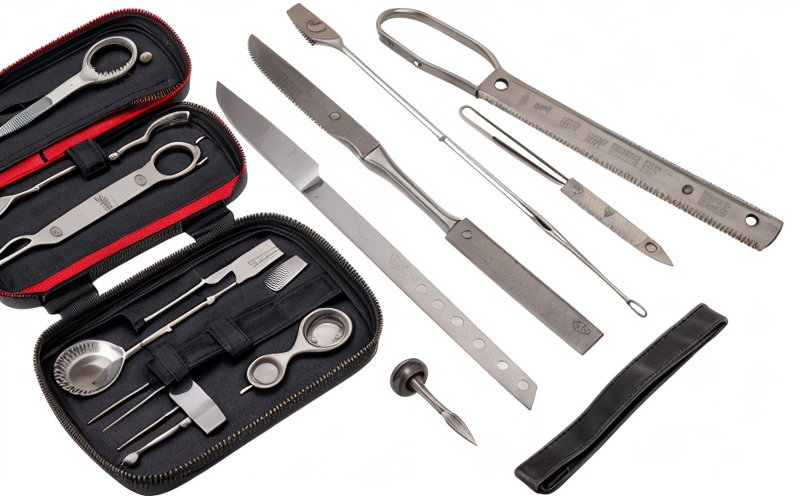Torque Output Testing of Powered Surgical Drills
In the medical device industry, ensuring that surgical tools such as powered surgical drills meet stringent torque output specifications is critical for patient safety and effective surgical procedures. This service focuses on testing the torque output of these devices to ensure they operate within specified limits.
The torque output of a powered surgical drill directly impacts its performance during surgery. Excessive torque can damage tissues, leading to complications such as bone fractures or nerve injury. Conversely, insufficient torque may result in incomplete drilling, necessitating additional procedures and increasing the risk for patients. Therefore, rigorous testing is essential.
The testing process involves subjecting the surgical drill to various loads and measuring its response. The device must be able to maintain a consistent torque output under different conditions, including varying speeds and loads. This ensures that it behaves predictably during real-world surgical scenarios.
For accurate results, specimens are prepared by simulating the drilling task with appropriate materials. These materials mimic bone or soft tissue properties as closely as possible to ensure realistic testing outcomes. The specimen is then clamped into a fixture designed to simulate the drill's grip on bone during surgery.
The test apparatus typically includes a high-precision torque sensor connected to a computerized data acquisition system. This setup allows for precise measurement and recording of torque values throughout the test run. Engineers analyze these data points to determine if the device meets predefined acceptance criteria.
Acceptance criteria are based on international standards such as ISO 14794-2, which specifies performance requirements for powered surgical instruments. Compliance with these standards ensures that the devices comply with global regulatory requirements and provide consistent performance across different surgical applications.
The testing procedure involves running multiple test cycles to account for variability in the device's torque output over time or under varying conditions. Engineers review all data points, identifying any outliers or inconsistencies that could indicate potential issues with the device's performance.
| Application Example | Testing Scenario |
|---|---|
| Titanium Bone Screw Insertion | Testing the drill's torque output during insertion of titanium bone screws to ensure proper engagement and avoid over-torquing. |
| Bone Biopsy Procedure | Evaluating the drill's performance in obtaining a representative biopsy sample while ensuring minimal tissue damage. |
| Arthroscopic Surgery | Maintaining consistent torque output during arthroscopic surgeries to prevent accidental over-torquing of drills used for cartilage repair. |
| Cranial Implantation | Ensuring the drill's torque output is appropriate for cranial implantations to avoid unnecessary stress on surrounding bone structures. |
- Testing for compliance with ISO 14794-2
- Evaluation of torque consistency across different drilling speeds
- Detection of potential over-torquing scenarios during simulated surgeries
- Assessment of drill's performance under varying loads to ensure reliability
Why Choose This Test
Choosing torque output testing for powered surgical drills is crucial for several reasons. Firstly, it enhances patient safety by ensuring that the device does not exceed safe torque limits during surgery, reducing the risk of tissue damage and complications.
Secondly, this test contributes to regulatory compliance, helping manufacturers meet stringent international standards such as ISO 14794-2. Compliance with these standards is essential for obtaining necessary certifications and approvals from health authorities worldwide.
The test also aids in product development by identifying any design flaws or performance issues early in the product lifecycle. This allows engineers to make necessary adjustments before full-scale production, resulting in higher-quality products that meet market demands.
Additionally, this service supports ongoing quality assurance efforts. By regularly testing torque output, manufacturers can ensure consistent performance across batches of devices and maintain a high standard of reliability throughout the product's lifecycle.
Quality and Reliability Assurance
Ensuring the quality and reliability of powered surgical drills is paramount in the medical device industry. The torque output test plays a critical role in this process by providing data that can be used to assess the device's performance under various conditions.
The testing procedure involves rigorous calibration of the torque sensor and alignment of the fixture to ensure accurate measurements. Engineers perform multiple cycles to account for any variability in the system, ensuring consistent results across all tests.
Data analysis is conducted using statistical methods to identify trends and outliers. Any deviations from expected values are investigated thoroughly to determine their cause and impact on device performance. This process helps engineers make informed decisions regarding design modifications or production adjustments.
Regular testing also facilitates compliance with international standards, ensuring that the devices meet the required specifications for both domestic and export markets. By adhering to these standards, manufacturers can gain trust from healthcare providers and regulatory bodies, which is essential for market success.





